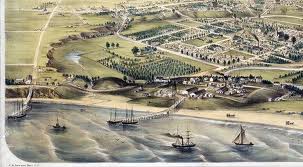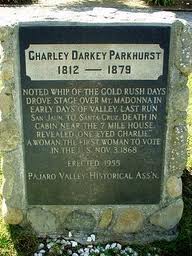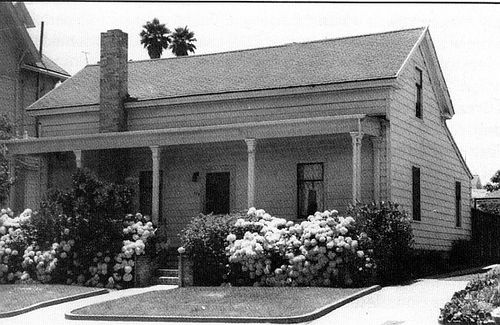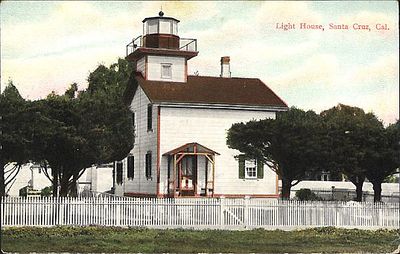History Pages: 27 - The Quiet Years
For a table of contents, see History pages.
The first half of the 1870s were relatively quiet in Santa Cruz. Big changes in transportation were approaching, but the geography of our end of Monterey Bay once again slowed the process. The first San Francisco-to-San Jose railroad was completed in 1864. The first transcontinental rail line was completed in 1869. The Southern Pacific advanced right up to the county line at Pajaro in 1871. But there it stopped, due in part to a collapse of silver prices and railroad investments, resulting in a general economic slowdown known as the Panic of 1873.
Since Santa Cruz had neither silver nor railroads, the depression’s local effects were not too severe and life went on. While waiting for the train to arrive, Santa Cruzans continued to travel and ship freight by road and ship. By this time, wharves (aka piers) were in operation up and down the county coastline from Waddell Creek at the northern boundary to the Pajaro River mouth at the southern end, including two at Santa Cruz.
Those two wharves can be seen in this detail from an 1870 "birdseye" lithograph. At the far left is the wharf owned by the Davis and Cowell Lime and Cement Co. To the right is the California Powder Works wharf.
Regular stagecoaches and freight wagons ran “over the hill” to San Jose, both from Santa Cruz through Scotts Valley and also out of Soquel. A longer but less mountainous route was through Watsonville to Gilroy and San Juan Bautista (today's state route 129). Then as now, driving over the Santa Cruz Mountains can be a challenge. Some of those early stagecoach drivers became semi-legendary figures, like reclusive Charley Parkhurst. Only after Charley's death was it discovered that Charley was a woman.
A few new names on the signs date from this period. Up on Mission Hill, Azores-native Jackson Sylvar opened a saloon in 1872 (with residence upstairs) on the corner of High Street and what is now Sylvar Street (see a drawing in Elliott, p.f100), facing the mission plaza. Sylvar was one of the early immigrants to our area from the Azores Islands, which belong to Portugal. Nearly all of the early Portuguese families in the county came originally from the Azores. Sylvar’s saloon building was later moved around the corner onto High Street, where it still stands as an extensively remodeled private residence.
A few doors toward Mission Street from Sylvar's original location stands what was once the home of Francisco Alzina. The Alzina house was built c.1850, and is believed to be the oldest surviving wood-frame house in Santa Cruz. Alzina was another islander, from Minorca – a Mediterranean possession of Spain. Arriving at Monterey by sea in 1846, Alzina was one of the many who eventually found their ways to the north end of the bay. Alzina’s father-in-law Juan Gonzales was one of the original residents of Mission Santa Cruz. Alas, I searched in vain for the name Gonzales on a sign in Santa Cruz (the street in Watsonville is probably named for a different Gonzales).
The Westside was growing, too. At what’s now the corner of Mission and King, the Pope House was becoming a popular haven for out-of-town visitors. I’m guessing, however, that its popularity increased greatly after 1875, when the old tannery behind it (formerly owned by Richard Kirby) finally shut down - tanneries do not smell good.
Out to the west along Mission Street, at the furthest reaches of “town”, dairyman L. K. Baldwin built a new house in 1873. Today’s Baldwin Street runs along the former eastern edge of that property. You can see from this 1879 drawing (from Elliott) that Baldwin was pretty much alone out there at that time. The Westside location was close to his dairy ranch, but probably smelled a lot better. Many prosperous Santa Cruz County ranchers/farmers built town houses during the later 1800s.
Another major change happened out on Point Santa Cruz. Amos Rountree leased the point to the US government, and a new lighthouse was built there in 1869. The building was considered picturesque enough for the postcard shown at left.
Principal sources:
- John L.Chase, The Sidewalk Companion to Santa Cruz Architecture (2005 book), 3rd edition
- W. W. Elliott, Santa Cruz County, Calif. Illustrations, with Historical Sketch (1879 book), 1997 expanded edition
Next: History Pages: 27 - How the trains came to Santa Cruz (part 1)



